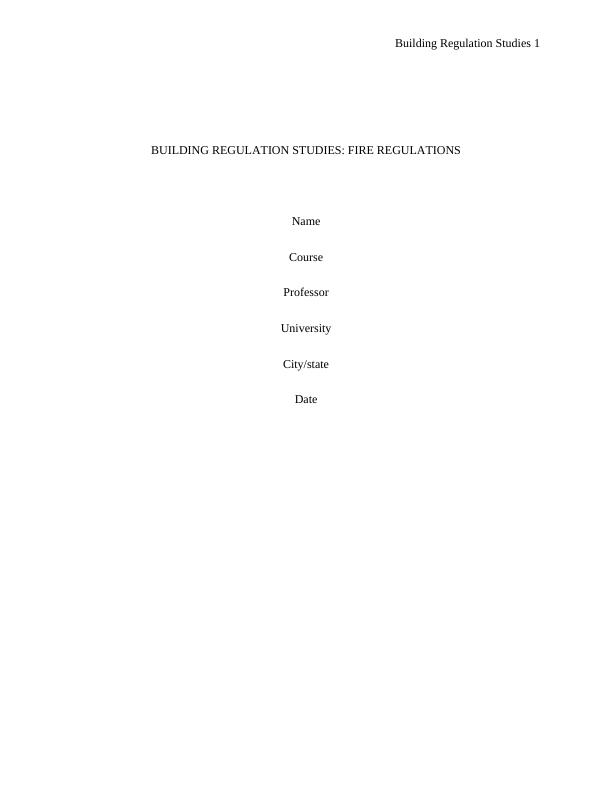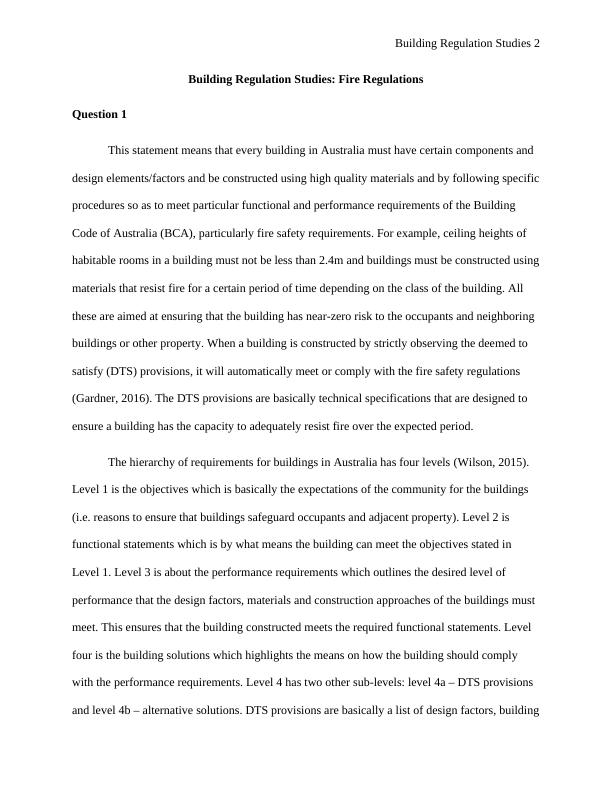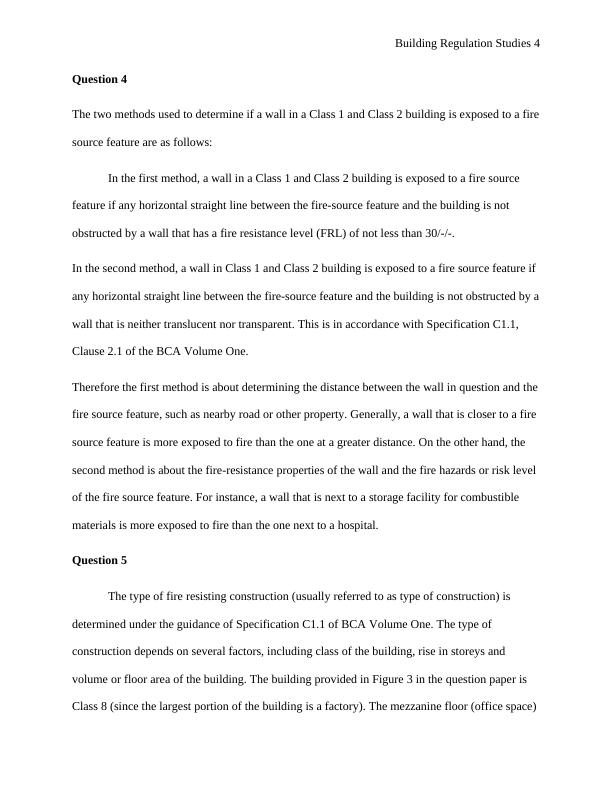Building Regulation Studies: Fire Regulations
Added on 2023-06-05
11 Pages2930 Words229 Views
Building Regulation Studies 1
BUILDING REGULATION STUDIES: FIRE REGULATIONS
Name
Course
Professor
University
City/state
Date
BUILDING REGULATION STUDIES: FIRE REGULATIONS
Name
Course
Professor
University
City/state
Date

Building Regulation Studies 2
Building Regulation Studies: Fire Regulations
Question 1
This statement means that every building in Australia must have certain components and
design elements/factors and be constructed using high quality materials and by following specific
procedures so as to meet particular functional and performance requirements of the Building
Code of Australia (BCA), particularly fire safety requirements. For example, ceiling heights of
habitable rooms in a building must not be less than 2.4m and buildings must be constructed using
materials that resist fire for a certain period of time depending on the class of the building. All
these are aimed at ensuring that the building has near-zero risk to the occupants and neighboring
buildings or other property. When a building is constructed by strictly observing the deemed to
satisfy (DTS) provisions, it will automatically meet or comply with the fire safety regulations
(Gardner, 2016). The DTS provisions are basically technical specifications that are designed to
ensure a building has the capacity to adequately resist fire over the expected period.
The hierarchy of requirements for buildings in Australia has four levels (Wilson, 2015).
Level 1 is the objectives which is basically the expectations of the community for the buildings
(i.e. reasons to ensure that buildings safeguard occupants and adjacent property). Level 2 is
functional statements which is by what means the building can meet the objectives stated in
Level 1. Level 3 is about the performance requirements which outlines the desired level of
performance that the design factors, materials and construction approaches of the buildings must
meet. This ensures that the building constructed meets the required functional statements. Level
four is the building solutions which highlights the means on how the building should comply
with the performance requirements. Level 4 has two other sub-levels: level 4a – DTS provisions
and level 4b – alternative solutions. DTS provisions are basically a list of design factors, building
Building Regulation Studies: Fire Regulations
Question 1
This statement means that every building in Australia must have certain components and
design elements/factors and be constructed using high quality materials and by following specific
procedures so as to meet particular functional and performance requirements of the Building
Code of Australia (BCA), particularly fire safety requirements. For example, ceiling heights of
habitable rooms in a building must not be less than 2.4m and buildings must be constructed using
materials that resist fire for a certain period of time depending on the class of the building. All
these are aimed at ensuring that the building has near-zero risk to the occupants and neighboring
buildings or other property. When a building is constructed by strictly observing the deemed to
satisfy (DTS) provisions, it will automatically meet or comply with the fire safety regulations
(Gardner, 2016). The DTS provisions are basically technical specifications that are designed to
ensure a building has the capacity to adequately resist fire over the expected period.
The hierarchy of requirements for buildings in Australia has four levels (Wilson, 2015).
Level 1 is the objectives which is basically the expectations of the community for the buildings
(i.e. reasons to ensure that buildings safeguard occupants and adjacent property). Level 2 is
functional statements which is by what means the building can meet the objectives stated in
Level 1. Level 3 is about the performance requirements which outlines the desired level of
performance that the design factors, materials and construction approaches of the buildings must
meet. This ensures that the building constructed meets the required functional statements. Level
four is the building solutions which highlights the means on how the building should comply
with the performance requirements. Level 4 has two other sub-levels: level 4a – DTS provisions
and level 4b – alternative solutions. DTS provisions are basically a list of design factors, building

Building Regulation Studies 3
components, materials and construction methods that will enable attainment of BCA’s
performance requirements if used. Alternative solutions entail innovative or other materials and
construction approaches that can be used to conform to the performance requirements of BCA
(Ellison, 2018).
Question 2
The classification of the building provided in Figure 1 in the question paper is Class 1a.
This is because the complex has several attached dwellings with each dwelling being a building
(Australian Building Codes Board, 2016). Another reason is that the attached dwellings are
separated by a common fire-resisting wall. This is building classification is in accordance with
Section A, Part A3 of National Construction Codes (NCC) Volume One (Australian Building
Codes Board, 2015).
Question 3
The rise in storeys (RIS) is the sum of the highest number of floors or storeys, including
those at the building’s external walls and within the roof space. Since the ceiling height is not
more than 1 m above the finished ground level’s lowest 12 m section and the ground floor or
basement is exclusively for vehicles’ accommodation (car park), the basement is not considered
in calculation of RIS. The method of calculating RIS is provided in clause C1.2 of the BCA
Volume 1. The rise in storeys is used to estimate the fire risk of a building.
The building in Figure 2 is class 2 because it comprises of several sole occupancy dwellings with
each dwelling being a separate unit. The total storeys of the building are three but the ground
floor is only for accommodating cars hence not counted in RIS (Victorian Building Authority,
2018). Therefore the RIS for the building is 2 (2 x Class 2 storeys).
components, materials and construction methods that will enable attainment of BCA’s
performance requirements if used. Alternative solutions entail innovative or other materials and
construction approaches that can be used to conform to the performance requirements of BCA
(Ellison, 2018).
Question 2
The classification of the building provided in Figure 1 in the question paper is Class 1a.
This is because the complex has several attached dwellings with each dwelling being a building
(Australian Building Codes Board, 2016). Another reason is that the attached dwellings are
separated by a common fire-resisting wall. This is building classification is in accordance with
Section A, Part A3 of National Construction Codes (NCC) Volume One (Australian Building
Codes Board, 2015).
Question 3
The rise in storeys (RIS) is the sum of the highest number of floors or storeys, including
those at the building’s external walls and within the roof space. Since the ceiling height is not
more than 1 m above the finished ground level’s lowest 12 m section and the ground floor or
basement is exclusively for vehicles’ accommodation (car park), the basement is not considered
in calculation of RIS. The method of calculating RIS is provided in clause C1.2 of the BCA
Volume 1. The rise in storeys is used to estimate the fire risk of a building.
The building in Figure 2 is class 2 because it comprises of several sole occupancy dwellings with
each dwelling being a separate unit. The total storeys of the building are three but the ground
floor is only for accommodating cars hence not counted in RIS (Victorian Building Authority,
2018). Therefore the RIS for the building is 2 (2 x Class 2 storeys).

Building Regulation Studies 4
Question 4
The two methods used to determine if a wall in a Class 1 and Class 2 building is exposed to a fire
source feature are as follows:
In the first method, a wall in a Class 1 and Class 2 building is exposed to a fire source
feature if any horizontal straight line between the fire-source feature and the building is not
obstructed by a wall that has a fire resistance level (FRL) of not less than 30/-/-.
In the second method, a wall in Class 1 and Class 2 building is exposed to a fire source feature if
any horizontal straight line between the fire-source feature and the building is not obstructed by a
wall that is neither translucent nor transparent. This is in accordance with Specification C1.1,
Clause 2.1 of the BCA Volume One.
Therefore the first method is about determining the distance between the wall in question and the
fire source feature, such as nearby road or other property. Generally, a wall that is closer to a fire
source feature is more exposed to fire than the one at a greater distance. On the other hand, the
second method is about the fire-resistance properties of the wall and the fire hazards or risk level
of the fire source feature. For instance, a wall that is next to a storage facility for combustible
materials is more exposed to fire than the one next to a hospital.
Question 5
The type of fire resisting construction (usually referred to as type of construction) is
determined under the guidance of Specification C1.1 of BCA Volume One. The type of
construction depends on several factors, including class of the building, rise in storeys and
volume or floor area of the building. The building provided in Figure 3 in the question paper is
Class 8 (since the largest portion of the building is a factory). The mezzanine floor (office space)
Question 4
The two methods used to determine if a wall in a Class 1 and Class 2 building is exposed to a fire
source feature are as follows:
In the first method, a wall in a Class 1 and Class 2 building is exposed to a fire source
feature if any horizontal straight line between the fire-source feature and the building is not
obstructed by a wall that has a fire resistance level (FRL) of not less than 30/-/-.
In the second method, a wall in Class 1 and Class 2 building is exposed to a fire source feature if
any horizontal straight line between the fire-source feature and the building is not obstructed by a
wall that is neither translucent nor transparent. This is in accordance with Specification C1.1,
Clause 2.1 of the BCA Volume One.
Therefore the first method is about determining the distance between the wall in question and the
fire source feature, such as nearby road or other property. Generally, a wall that is closer to a fire
source feature is more exposed to fire than the one at a greater distance. On the other hand, the
second method is about the fire-resistance properties of the wall and the fire hazards or risk level
of the fire source feature. For instance, a wall that is next to a storage facility for combustible
materials is more exposed to fire than the one next to a hospital.
Question 5
The type of fire resisting construction (usually referred to as type of construction) is
determined under the guidance of Specification C1.1 of BCA Volume One. The type of
construction depends on several factors, including class of the building, rise in storeys and
volume or floor area of the building. The building provided in Figure 3 in the question paper is
Class 8 (since the largest portion of the building is a factory). The mezzanine floor (office space)

End of preview
Want to access all the pages? Upload your documents or become a member.
Related Documents
Regulation Report for High Risk Buildinglg...
|7
|2349
|310
Building Assessment and Regulation Reportlg...
|17
|2508
|414
ENS5112 Construction Site Managementlg...
|6
|937
|68
Building Regulation Studies Question 2022lg...
|7
|1417
|19
300885 Building Regulation Studies – Spring 2019.lg...
|4
|680
|77
Deem to Satisfy Provision and Building Classification in BCAlg...
|4
|598
|441
